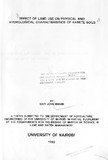Resource information
Soil physical and hydrological properties of kabete soils were
evaluated at three different land use sites namely forest,
grass la n d , and cropland sites. The purpose of this work was to
determine the effect of selected land uses on phy si caI and
hydrological characteristics of the kabete soils in Kenya.
Soil samples for this study were collected from the College of
Agriculture and Veterinary Sciences (CAVS), field station. Soil
samples for the determination of bulk density, organic matter
content, particle size distribution, soil aggregate stability,
soil erodibility indices, pore size distribution, soil moisture
release characteristics, profile water holding capacity, available
water capacity, and saturated hydraulic conductivity, were
collected from 0, 10, 30, 60 and 100 soil depth at four different
representative areas on each site. Soil samples were then taken
for laboratory analysis of physical and hydrologic soil properties
using standardized laboratory procedures.
The bulk density for the cropland had an average value of
1.16 g -3 em as opposed to forest and grassland sites with average
va1ues af 1 .02 and 1 .1 g cm-3 respec t'lve1y. 0rganl.c matt.er con-ten t
showed a high value of 4.04% at the forest site, grassland and
cropland sites had organic matter content values of 3.51 and 2.77%
respectively. Particle size distribution, soil aggregate
stability and soil erodibility
indices showed significant differences between the three sites.
The forest site showed higher readily available water content
than the other two sites. The cropland site had the highest amount
of non readily available water than grassland and forest sites.
The three sites showed different patterns of soil moisture release
characteristic curves depending on the soil texture and organic
matter content of each site. Field capacity, permanent wilting
point, available water capacity, and saturated hydraul ic
conductivity for the three sites varied significantly at the soil
surface as well as at the 100 cm soil depth.


